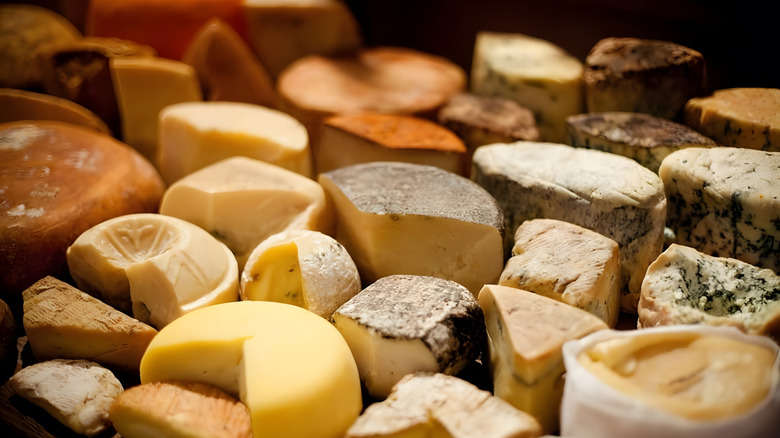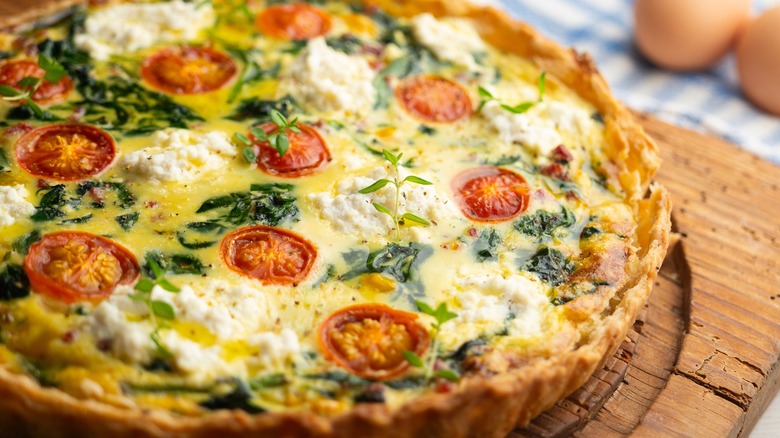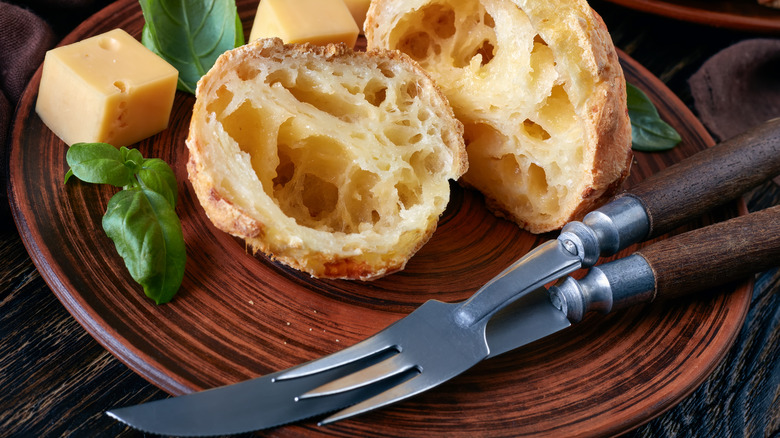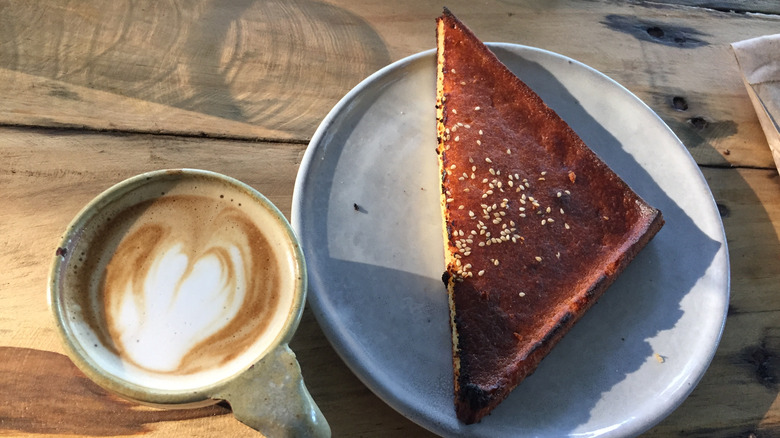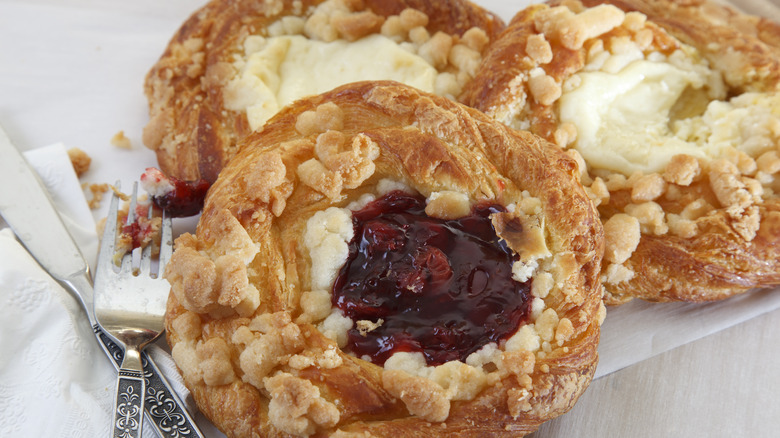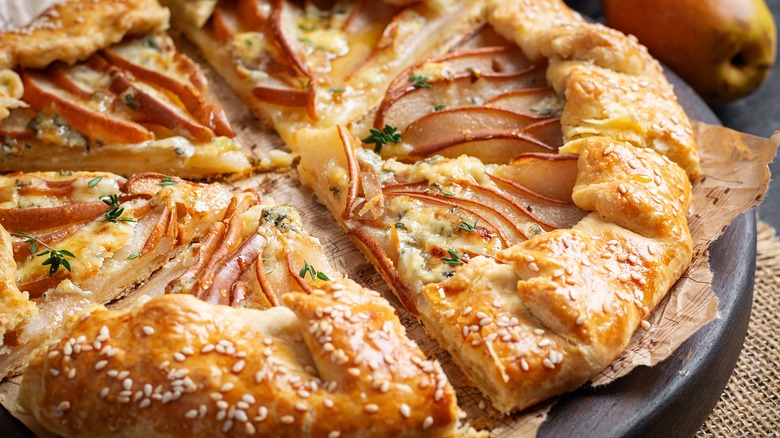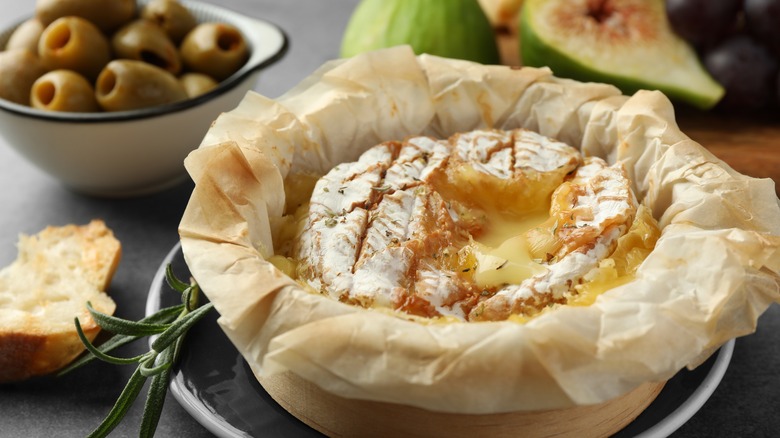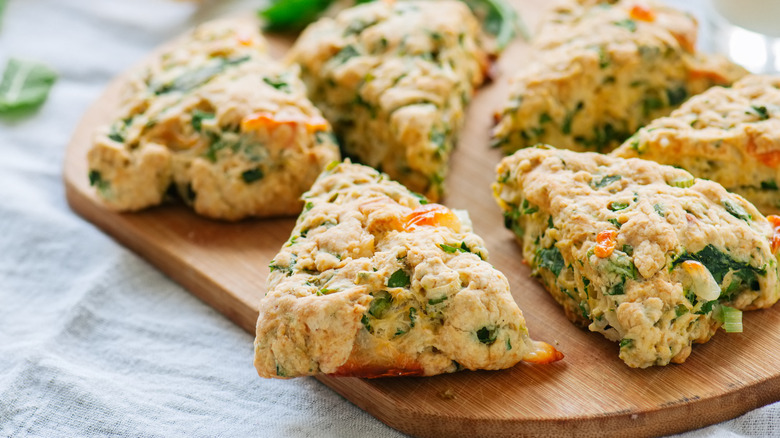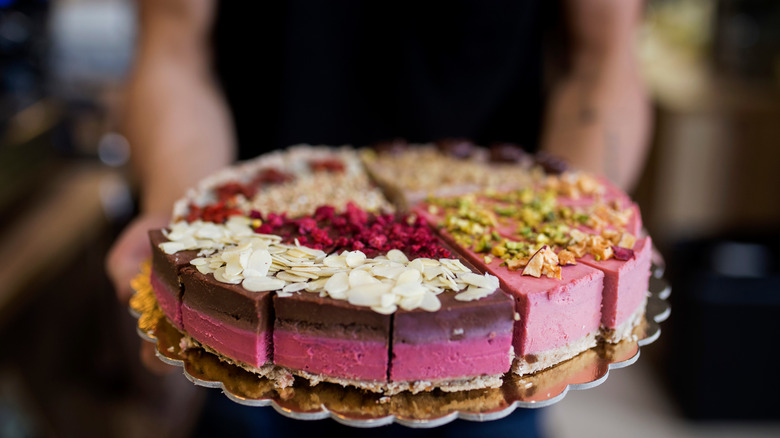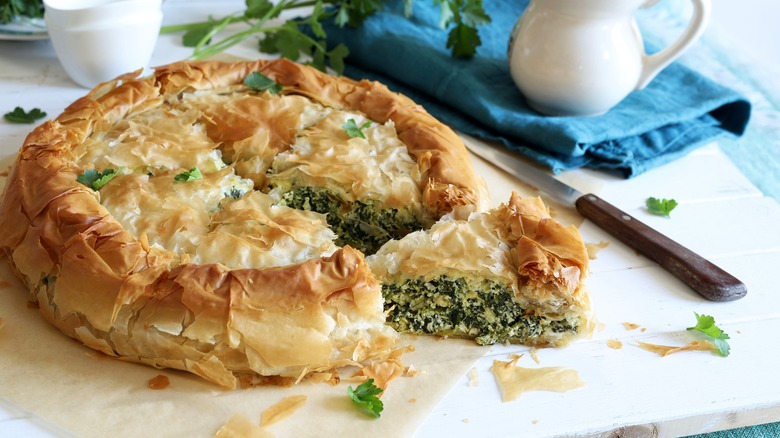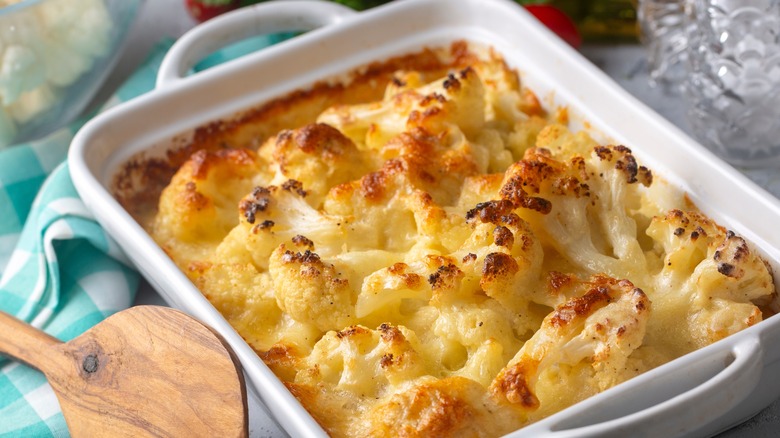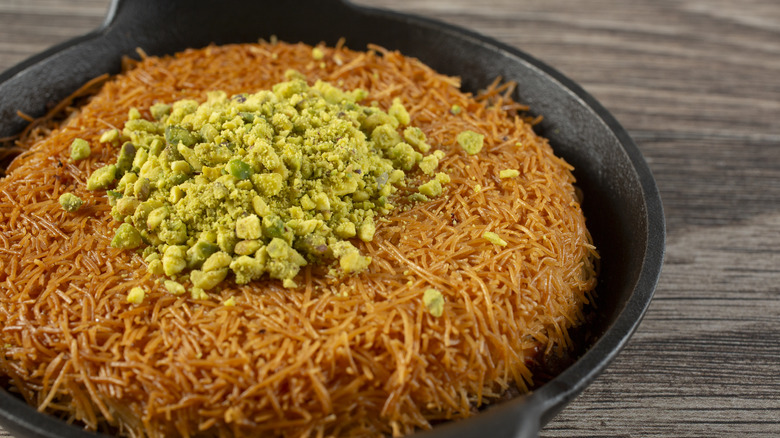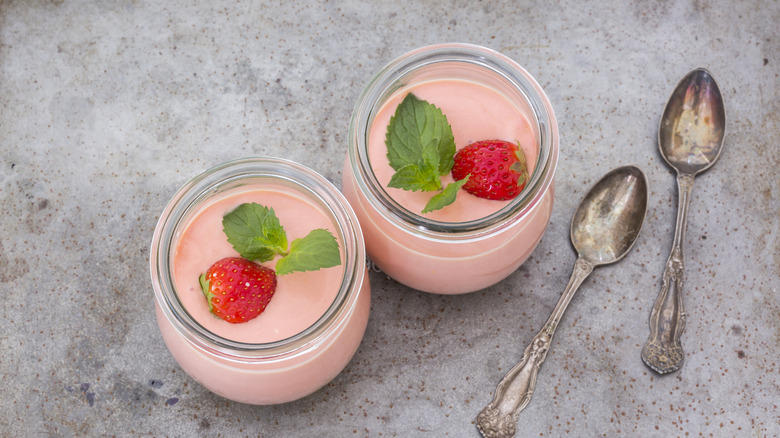12 Creative Ways To Use Cheese In Your Baking
You'd be hard pressed to find a person alive who doesn't love cheese. It seems to be most vegetarians' reason for not going vegan — cheese is just too good to give up. Using it in baking is a gratifying experience, you get to watch the product go from cold and unspreadable to warm, melting, inviting. The diverse textures, flavors, and types of cheese available open up a world of opportunity for the creative baker.
We interviewed four experts in the pastry world, who weighed in on their favorite flavor combinations, techniques, dishes, and pastries to combine with different cheeses. Tarciani Harger of Soby's New South Cuisine says, "Cheese is a living ingredient — it brings depth, character, and surprise to baking." The experts encourage bakers to branch out with their creativity. "Taste as you go," says Odette D'Aniello of Dragonfly Cakes, "trust your instincts, and most of all, have fun with it. Sometimes the best flavor combos come from trying something unexpected."
To source your cheeses, cookbook author Jessie-Sierra Ross encourages bakers to go beyond the grocery store to discover new flavors. "Get to know your local cheese-monger or cheese shop," she says, "there are so many styles and varieties of cheese out there." Once you've sourced the perfect cheese to bake with, Dominick Miller of Lady Jasmine Cakes instructs to "consider the flavor characteristics of the cheese you want to use, and build the dessert or flavors around it." Use these expert-recommended ideas as a starting ground for your next cheese-inspired baked good.
Start your day with a quiche
Using cheese in a quiche is simply a must — who doesn't love cheese with their eggs? Odette D'Aniello of Dragonfly Cakes doesn't shy away from cheese, and prefers to use three different kinds to complement this savory baked custard dish: "Mozzarella for that gooey texture, a nice sharp cheddar for bite, and Swiss for a little nutty, umami tang."
There are two important things to consider in order to make your quiche restaurant-worthy. The first is to use a pie crust recipe you know will have a flaky texture and excellent taste; a store-bought pie crust or one that's too bready will only be left behind for the garbage bin. The second important step is, if you're using vegetables in your quiche, to cook them down and season before mixing them into the custard. This will prevent excess water from seeping out during the bake and ensure that your quiche is packed with flavor through and through.
Playing with your flavor combinations on a quiche is fun — all you need to do is think of what you like to eat with eggs. Love an avocado toast in the morning? Bake the cheese of your choice, bacon, and green onion into the custard and arrange some thin avocado slices on top once it's cooled. If you want to avoid using meat, try a vegetable-based mushroom and leek quiche and sprinkle a nutty manchego or rich gruyère over the top.
Try your hand at gougères
You may have seen these small French pastries served as an amuse-bouche in upscale restaurants. They feature a crispy top and an airy interior perfect for stuffing with cheese-based fillings that burst with flavor when you bite into them. Made with a choux dough that's topped with craquelin before baking, cheese can be rolled into the dough before baking and included in the filling you pipe into them once cooled.
Making a choux dough requires a bit of science and technique, but will definitely be worth the process in the end. Once the successful choux dough is piped onto a baking sheet it's topped with circles of craquelin. Made from butter, flour, and sugar, this cookie-like dough is rolled into thin sheets, chilled, and punched into small circles. It gives the final product a deliciously sweet crust that is also very appealing to the eye.
If you're going with a savory filling, you can start with a bèchamel sauce and add manchego and toasted almonds, camembert and wine-cooked mushrooms, brie and apples, or whatever other combination your heart desires. The only thing to keep in mind is to make sure your filling is thick enough that it won't immediately run out of the hole you pipe it into. If you're going the sweet route, use a soft cheese like mascarpone, cream cheese, or ricotta as your base and add in salted or candied lemon peel, syrup-poached cherries, or a dollop of cookie butter or Nutella for extra richness.
Upgrade your bread with cheese
If you're craving a bread that will lay you out on the couch in a food coma, a cheesy pull-apart bread will definitely do the trick. Separate your homemade or store bought dough into sections, coating them generously with garlic butter and asiago, sharp cheddar, or creamy havarti. Layer them into a pan and, once baked, enjoy tearing apart the cheesy layers. If you'd rather not go to the hassle of starting from scratch, you can use a store bought loaf, cut hash marks halfway through while keeping the loaf intact, and sprinkle cheese and garlic butter into the cracks. Bake just long enough to melt the cheese.
Tarciani Harger, the pastry chef of Soby's New South Cuisine in South Carolina weighed in on one of her favorite ways to incorporate cheese into bread. "I'm Brazilian," she says, "and we have a very popular snack there called pão de queijo" (which translates to cheese bread). "It's made with parmesan cheese and goes very well with different types of fillings, such as guava jam and dulce de leche." A similar cheesy creation originates from El Salvadore, called a "quesadilla" although bearing no resemblance to the Mexican tortilla version, this naturally gluten free cake is made with rice flour and earns the quesadilla title from the parmesan cheese and sour cream that give it moisture and rich flavor. It's a little sweet, quite filling, and delicious to snack on.
Don't shy away from sweet
The many applications for cheese in savory baking shouldn't distract you from the opportunity to use cheese in your sweet treats as well. Mascarpone, ricotta, and cream cheese are all soft cheeses with relatively mild flavors, making them the perfect companion to add texture and richness to sweet pastry fillings. Cream cheese is commonly used in danishes and turnovers whipped with egg, sugar, and vanilla extract, resulting in a delicious bake-able filling that can be combined with all sorts of fruity or chocolatey toppings. Ricotta can even be mixed in to Italian cookie dough, usually combined with lemon zest, to make a thick, moist cookie packed with flavor.
Cheese isn't just for pastries — two of our Chowhound experts said they love to use soft cheeses in their cake fillings. Dominick Miller of Lady Jasmine Cakes describes a whipped cream cheese filling that bears resemblance to cream cheese frosting but "is lighter in texture, a lot less sweet, and allows the tang of the cream cheese to shine." He pairs this fluffy filling with a rainbow carrot cake and lemon curd. Tarciani Harger of Soby's New South Cuisine likes to use mascarpone, cream cheese's rich Italian cousin, in her cake fillings. "If you combine it, for example, with white chocolate, the result is a silky ganache with a slightly sweet texture; which allows me to combine it with a multitude of fruit and nut flavors."
Get creative with galettes
Galettes are a French pastry that beg to be filled with different combinations of cheese, meats, fruits, or vegetables. Classically made with puff pastry or pie crust with edges folded up over the filling to form a thick crust, they result in a delicious pastry that can be made in single servings or large pies. A galette Bretonnes is a variation made with a buckwheat crepe in place of pastry dough, encasing ham, cheese, and a runny egg poking out of the center.
These pastries beg for a cheesy filling that will meld together with the juices of poached fruits or roasted vegetables. Odette D'Aniello, the founder of Dragonfly Cakes, describes galettes as "versatile and forgiving." Her favorite flavor pairings involve goat cheese and fruit or savory asparagus, tomato and feta, or caramelized onion and gruyere cheese. "They're the perfect canvas for both savory and sweet flavors, and cheese fits naturally into both," she says. Start with your choice of dough and favorite cheese, and get creative with toppings to make this appealing pastry that will elevate any cheese into an irresistible presentation.
Make the cheese the star
If you love cheese, there's nothing better than baking a whole round of it in the oven until it's reached ethereal levels of creamy and melted. There are several toppings you should try on brie, and poached fruits or caramelized onion are among the best, especially when dipped into the cheese with a hearty chunk of toasted bread. Sometimes the cheese is the star and deserves to be put on a pedestal. Odette D'Aniello of Dragonfly Cakes reminisces about a time in Portugal when she indulged in a block of goat cheese drizzled with honey and caramelized under a broiler. "My family still talks about it to this day," she says.
A baked cheese doesn't need much to make it more enticing than it already is. Camembert, brie, and goat cheese are the common choices for a good baked cheese. Some cooks like to bake them in puff pastry which serves as a crust, but if you don't have that on hand, all you really need are some good crackers or bread to scoop the melted cheese up with. If you want to take it to the next level, you don't necessarily need to choose between sweet or savory. Place your cheese into a baking dish and garnish either end like a warm charcuterie board. For the sweet side, reach for your favorite jam, marmalade, or preserved fruits. For savory, try roasted vegetables like mushrooms, fennel, or shallots. Nuts will add an element of texture and fresh or fried herbs will add even more complexity to this centerpiece-worthy dish.
Fold it into scones
There's nothing better than a freshly baked scone coming hot out of the oven, steam filling the air as you break it open to be slathered in butter or spread with honey and clotted cream. Cheese is a natural addition to this quick-bread pastry, opening doorways to sweet or savory routes.
To make your scone a savory delicious snack oozing with cheese and filling flavors, start with your favorite cheese. If it's a smoked gouda, think about pairing it with chopped bits of par-cooked bacon and thinly sliced scallions for a breakfast-worthy scone. If you love mozzarella, try adding chopped sun-dried tomatoes and Kalamata olives with a sprinkling of oregano for a scone bursting with Mediterranean flavor. Jessie-Sierra Ross, cookbook author of "Seasons Around The Table" says her favorite scone is one stuffed with shredded cheddar cheese, green herbs, and minced shallot, describing it as "crispy on the top, and tender on the inside."
If you're craving something sweet, some cheeses pair wonderfully with fruits and sweeter flavors and will blend into a lovely scone. Ever enjoyed a slice of apple pie or crumble with a piece of cheddar cheese? Try mixing some stewed apples into your scone and topping it with a sprinkling of sharp white cheddar. A bit of ricotta and honey in place of cream will add moisture, and you can fold in candied almonds or pecans for added crunch.
Take your cheesecake to the next level
Given its name, cheesecake may be most people's first thought when they think of using cheese in baking. The commonality of this dessert shouldn't sway you to think it's overdone or basic — there are many renditions that make a simple recipe a playground for the creative baker. A New York cheesecake is known for being dense and rich, a Chicago-style uses more cream cheese, a Basque cheesecake will be lighter with a burnt exterior, a Japanese-style is souffléed, and an Italian cheesecake will use ricotta or mascarpone, yielding a unique flavor. The options are ripe for the picking depending on what kind of texture you're going for.
Once you've nailed down your ideal base, the world is yours in terms of choosing the flavors that pair best. Dominick Miller of Lady Jasmine Cakes in Sonoma Valley touts a goat cheese cheesecake as one of his favorites, and likes to pair it with chamomile or lavender infused shortbread crusts with apple butters, or Meyer lemon curd gracing the top. He says, "I love this goat cheese cheesecake recipe's versatility; providing me with a blank canvas to showcase seasonal fruits of Sonoma throughout the year." Cookbook author Jessie-Sierra Ross opts for a tahini-infused cheesecake batter topped with plum coulis. She says the "toasted sesame seed and almond meal crust plays so well with the creamy cheesecake, and the plum-based sauce is juicy and sweet."
Liven up savory pastries
There are an endless amount of savory pastries serving as perfect vessels to carry the flavor and texture of cheese comfortably to your mouth. From Greece to Mexico, many cultures have developed a plethora of cheese-based pastries that have been filling happy bellies for hundreds of years. Any of these pastries can be used as a base for your own creative vision. Choose the pastry that sounds best to you, decide on a cheese, and incorporate any other meats, vegetables, or herbs you need to round it out.
Danishes may be the first to come to mind when you think of cheese-filled pastries. In savory form they often appear in neighborhood bakeries with goat cheese and asparagus or gruyere and mushroom fillings. In Greece, spanakopita is a regional classic made from feta cheese and stewed spinach. Its underrated cousin, tiropita, is not to be overlooked, made with a filling of onion, feta, and graviera, a hard Greek cheese similar to gruyere. The filling is placed inside butter-brushed layers of phyllo dough and folded into neat little triangles, which, once baked, will ooze tantalizing puddles of cheese filling from the corners. Across the ocean, Mexican (and South American) empanadas are a delicious way to use cheese, whether on its own or paired with corn and mushroom, ham, or beef. Try using stringy Oaxacan cheese to complement your baked or fried empanada.
Make your mac 'n' cheese gourmet
If you want a dish that will have everyone at the potluck designating you the mac 'n' cheese ruler, make sure you start with a béchamel and don't be shy with the cheese. Using more than one cheese is the best way to round out the flavor of your mac 'n' cheese sauce. Cookbook author Jessie-Sierra Ross says that "baked cheese is really incredible not just for its flavor, but for the richness it adds to each recipe." A combination of sharp cheddar or Swiss cheese, havarti, and smoked gouda will add complexity to your dish and take it from Kraft to king.
Jessie doesn't stop there with the baked dishes, using mess-free cauliflower in place of macaroni for a gluten free alternative. "Cauliflower with a creamy béchamel containing fontina, gruyere, and a little bit of minced garlic is another great "bake."" You can use the same cheesy béchamel sauce combined with different pastas, vegetables, rice, or potatoes to make a delicious dish perfect for sharing.
Experiment with Arabic pastries
Knafeh is a mouth-watering Arabic pastry made by coating white cheese in a mixture of toasted kataifi (that shredded phyllo dough popularized by the Dubai chocolate trend). It's baked with ghee until the exterior is crispy brown and the inside melts, and the final product is soaked in orange blossom syrup and topped with toasted pistachios. Does it get much better than that? Traditionally made with Arabic cheeses like Palestinian akkawi or Egyptian jibneh baida (white cheese), you can use a combination of mozzarella and ricotta to mimic the flavors if you find the Arabic version hard to come by.
Another more savory Arabic cheese pastry is called fatayer bi jibneh (cheese bread). Made from a yeasted dough that's pinched into a boat shape and filled with cheese and herbs, this pastry is sometimes topped with a runny egg and eaten for breakfast, or served as a snack throughout the day. You might be lucky enough to find some Arabic cheeses at your local specialty store or market, but if not you can easily swap them out for more common white cheeses. Get creative with your toppings and try using chimichurri, aleppo pepper, or ground beef with tomato to liven up this baked good.
Skip the baking with a cheese-based mousse
Cheese is often used in pastries that skip the baking step and opt for a cold mousse instead. Tiramisu is a prime example, where mascarpone is whipped, folded into sugar and cream and spread over coffee-soaked cookies to be chilled and set. That delicious whipped mascarpone and cream spread can be utilized as a filling for sandwiched cookies, a dip for scones, or set as a mousse and served with fresh berries.
Mascarpone is full of fat which helps it to set nicely into a mousse, although any of the soft cheeses can be utilized to make a mousse. Ricotta will bring a fresher flavor that pairs nicely with citrus and bright fruits, while cream cheese has a richness that combines with chocolate beautifully. If you want a more protein-rich option, even cottage cheese can be used to make a thick mousse that serves as a reasonably healthy snack. Play with a bit of thinly sliced manchego and toasted almonds, or shaved parmigiano reggiano as a topping.
